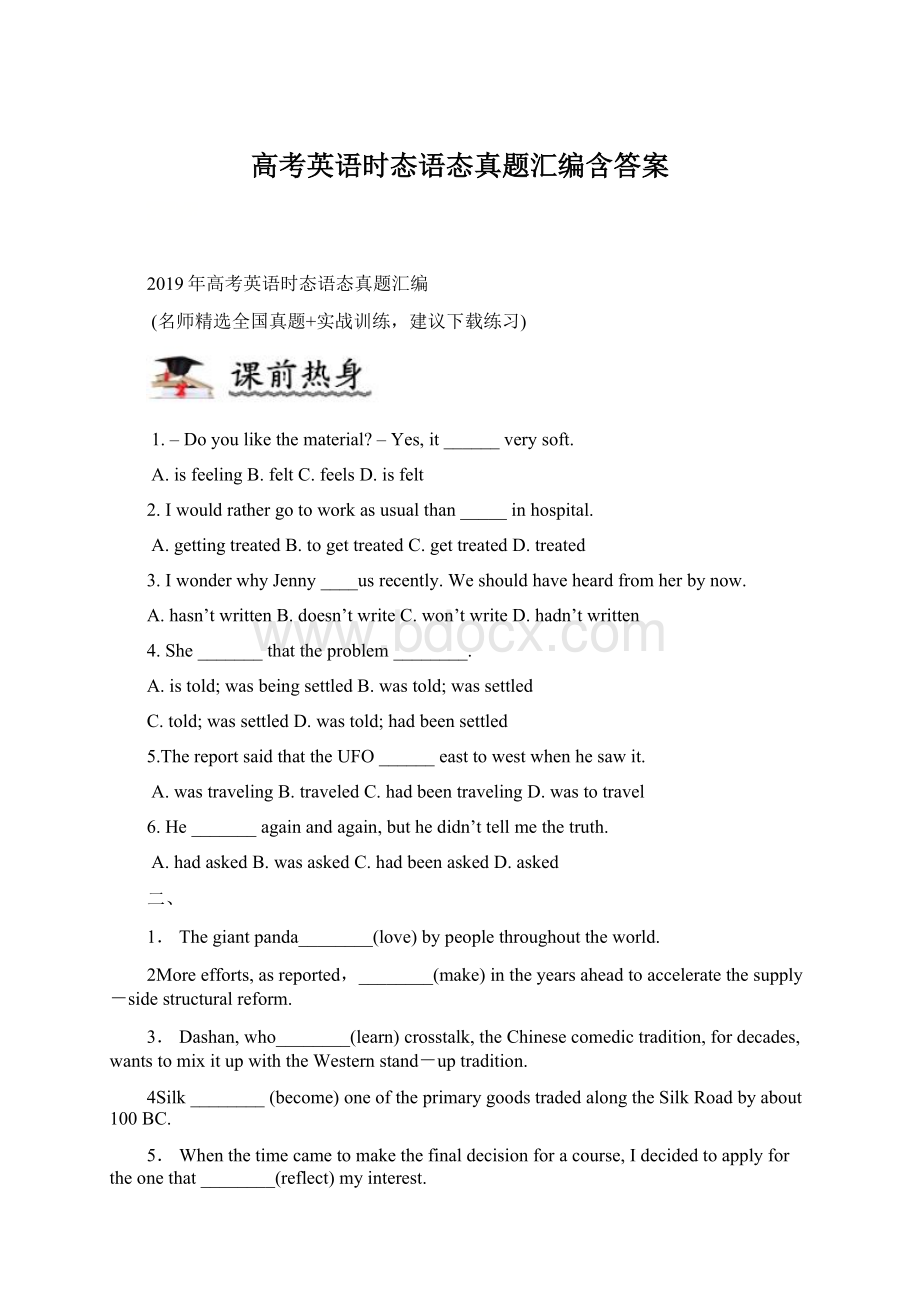高考英语时态语态真题汇编含答案.docx
《高考英语时态语态真题汇编含答案.docx》由会员分享,可在线阅读,更多相关《高考英语时态语态真题汇编含答案.docx(15页珍藏版)》请在冰豆网上搜索。

高考英语时态语态真题汇编含答案
2019年高考英语时态语态真题汇编
(名师精选全国真题+实战训练,建议下载练习)
1.–Doyoulikethematerial?
–Yes,it______verysoft.
A.isfeelingB.feltC.feelsD.isfelt
2.Iwouldrathergotoworkasusualthan_____inhospital.
A.gettingtreatedB.togettreatedC.gettreatedD.treated
3.IwonderwhyJenny____usrecently.Weshouldhaveheardfromherbynow.
A.hasn’twrittenB.doesn’twriteC.won’twriteD.hadn’twritten
4.She_______thattheproblem________.
A.istold;wasbeingsettledB.wastold;wassettled
C.told;wassettledD.wastold;hadbeensettled
5.ThereportsaidthattheUFO______easttowestwhenhesawit.
A.wastravelingB.traveledC.hadbeentravelingD.wastotravel
6.He_______againandagain,buthedidn’ttellmethetruth.
A.hadaskedB.wasaskedC.hadbeenaskedD.asked
二、
1.Thegiantpanda________(love)bypeoplethroughouttheworld.
2Moreefforts,asreported,________(make)intheyearsaheadtoacceleratethesupply-sidestructuralreform.
3.Dashan,who________(learn)crosstalk,theChinesecomedictradition,fordecades,wantstomixitupwiththeWesternstand-uptradition.
4Silk________(become)oneoftheprimarygoodstradedalongtheSilkRoadbyabout100BC.
5.Whenthetimecametomakethefinaldecisionforacourse,Idecidedtoapplyfortheonethat________(reflect)myinterest.
6.Therealreasonwhyprices________(be),andstillare,toohighiscomplex,andnoshortdiscussioncansatisfactorilyexplainthisproblem.
7.Asyougothroughthisbook,you________(find)thateachofthemillionsofpeoplewholivedthroughWorldWarⅡhadadifferentexperience.
8.Iwasn'tabletohidemyeagernesswhenI________(ask),“Whatdoyouwishmetodonow?
”
9.HemusthavesensedthatI________(look)athim.Hesuddenlyglancedatmeandsaidquietly,“Whyareyoustaringatmelikethat?
”
10.Ihadastrongdesiretoreachinandplaywiththetoy,but________(hold)backthankfullybytheshopwindow.
时态语态
英语16种时态
二、常见时态的基本用法
一般现在时
一般现在时是描述现在或经常性的动作性质或状态的时态。
(常和everytime,nowandthen,occasionally,often,seldom,sometimes,usually等连用)具体用法:
1)表示经常性或习惯性的动作。
Wehavethreemealsaday.
2)表示客观事实、真理和自然现象。
Knowledgeispower.
3)表示现在的情况或状态。
IliveinBeijing.
4)表示已经“列入日程”的将来的事件,尤其指计划中的和安排好的将来的动作,这些动词往往表示“出发,到达”等含义的词,
如,arrive,begin,go,leave,start,stay等。
Thetrainarrivesat10:
30.There'splentyoftime.。
考点一:
表示永恒的真理,即使出现在过去的语境中,仍用一般现在时。
如:
IlearnedthattheearthgoesaroundthesunwhenIwasinprimaryschool.
考点
二:
在时间和条件状语从句中,一般现在时表将来;常用的引导词有:
时间:
when,until,after,before,assoonas,once,themoment/theminute,theday;
条件:
if,unless,provided.
Ifheacceptsthejob,hewillgetmoremoneysoon.
Ifitrainstomorrow,Ishallstayathome.
Thenewsecretaryissupposedtoreporttothemanagerassoonasshearrives.
一般过去时
一般过去时表示过去发生的动作、存在的状态,或反复发生的动作,句中一般都有表示过去具体时间的时间状语。
具体用法:
1)表示在过去特定时间中一次或一度发生的动作或存在的状态。
a.有明确的过去时间:
yesterday,lastnight,…ago,justnow,in1980,inthepast…
b.对比现在Scientiststhinkthatthecontinentsweren’talwayswheretheyaretoday.
c.其他暗示Hecouldhavedoneitbetter,buthewastoocareless.
2)表示在过去一段时间内,经常性或习惯性的动作。
WhenIwasachild,Ioftenplayedfootballinthestreet.
3)用在条件句中表示与现在或将来事实不符的虚拟语气。
Ifhewereherenow,wecouldturntohimforhelp.
4)表始料未及的过去,即表过去的意识
、心态、看法等与现在不同,常用动词(know,realize,expect,recognize,mean…),表“没想到,没意识到,不知道”。
——Howtimeflies!
Italready10o’clock.——Oh,Ididn’trealizeit.
一般将来时
一般将来时用来表示将要发生的事。
(soon,tomorrow,n
extweek,someday,in(the)future)
1)shall用于第一人称,常被will代替。
will在陈述句中用于各人称,在征求意见时常用于第二人称。
will(shall)+动词原形往往指没有经过
计划而临时出现的意图,常伴有说话者的主观意识或表示将来必然发生的事。
2)begoingto+动词原形,既可指主观打算做某事,也可
指客观迹象表明将要发生某事
3)“be+不定式”,表示客观安排或受人指示而做某事
注意:
begoingto,will与beto的区别
1.I'mgoingtoquitmypresentjob.(现在的打算,事先经过思考,指向将来)
2.I'llanswerthedoor.(未经事先考虑的意图)
3.Thelittleboyisgoingtofallover.(根据客观迹象判断)
4.Ihopeitwillbefinetomorrow.(主观意愿)
5.WearetodiscussthereportnextSaturday.
6.Themeetingistotakeplaceat8:
00tomorrowmorning.
7.Iamtoplayfootballtomorrowafternoon.(客观安排)
8.Iamgoingtoplayfootballtomorrowafternoon.(主观安排)
4)“beabouttodo”意为“马上做某事”,表
示即将发生某事,该事将发生在很近的将来,不能与tomorrow,nextweek等表示明确将来的时间状语连用。
Hewasabouttoexplainwhensheinterruptedme..
5)beonthepointofdoing强调在很近的将来要发生的事。
Theyareonthepointofl
eaving.
考点一:
在时间、条件等状语从句中,一般现在时表一般将来时(见一般现在时,考点二)
考点二:
某些表示短暂性动作的动词如arrive,come,go,leave,start等,用现在进行时形式表示将来。
IamleavingforBeijingtomorrow.
考点三:
“祈使句+and/or+句子”,这种结构中and后面的句子谓语用一般将来时。
Useyourheadandyouwillfindaway.
过去将来时
过去将来时表示从过去某一时间看将要发生的动作或存在的状态。
注意:
这种时态常用于主句是一般过去时的宾语从句中,表示从句的动作发生在主句之后。
过去将来时同一般将来时类似,除了用woulddo表示外,也可以用begoingtodo,betodo,beabouttodo及过去进行时等方式表示。
Hewassixty-eightandintwoyears,hewouldbeseventy.
Youweregoingtogivemeyouraddressbutyoudidn't.
Iwasabouttoturnonthepowerofthecomputerwhentheelectricitywascutoff.
完成体(现在完成时、过去完成时、将来完成时、过去将来完成时)
现在完成时
1)表示动作到说话已经完成。
Hehaslosthiswalletandcan'tfindit.
Theyhavebeengoodfriendssincetheymetatameeting.
Youneedn'tdescribeher.Ihavemethermanytimes.
2)在时间或条件状语从句中表示在将来某个时间之前要完成某个动作。
Don'tgetoffuntilthebushasstopped.
常用现在完成时的句型有:
1)Itis/hasbeen+一段时间+since从句;
2)This/That/Itisthefirst/second...Time+that从句(从句用现在完成时);
3)It/Thisisthebest/worst/mostinteresting+名词+that从句(从句用现在完成时)
Hehaslivedheresince1980.
ThisisthemostinterestingbookthatIhaveeverread.
Itisthesecondtimethatyouhavebeenhere.
过去完成时
表过去某个时间或动作之前已经发生的动作或已经存在的状态;表“过去的过去”。
在使用过去完成时时,一定要有过去的时间或动作作为参照。
考点一:
“一……就……”
用于hardly/scarcely...when;nosooner...than句型中,主句用过去完成时,从句用一般过去时。
,并且nosooner与hardly等位于句首时,此部分须用部分倒装。
Ihadnosoonergotintotheroomthanitbegantosnow.
NosoonerhadIarrivedhomethanthetelephonerang.(注意主谓倒装)
考点二:
表示“第几次做某事”,主句用过去时,从句用过去完成时。
Thatwasthesecondtimethatshehadseenhergrandfather.
考点三:
动词hope,expect,think,intend,mean,want,s
uppose,plan表示主观想法的动词,可用于过去完成时表示过去未曾实现的想法、希望、打算或意图,意为“本来想......”
Theyhadwantedtohelp,buttheycouldnotgetthereintime.
将来完成时
主要用于表示在将来某一时间点上会完成的动作,并对将来某一时间产生影响。
常与将来时间状语连用。
Weshallhavefulfilledtheworkbytheendofnextweek.
考点一:
by+将来的时间;bythetime+一般现在时从句
Bytheendofnextmonth,hewillhavetraveled1000milesonfoot.
Bythetimeyoureachthestation,thetrainwillhaveleft.
BynextTuesday,Iwillhavegotreadyfortheexams.
考点二:
在时间和条件状语从句中,将来完成时则由现在完成时表示。
Thechildrenwilldotheirhomeworkthemomenttheyhavearrivedbackfromschool.
现在进行时:
1)表示说话时正在进行的动作或存在的状态。
或说话时没完成,仍在继续进行的动作或存在的状态。
常与now,rightnow,atthismoment,atpresent等时间状语连用。
Whataretheyquarrelingabout?
I'mteachingpart-timeinamiddleschool.
2)表示马上就要发生。
非延续性动词用于进行时态,往往表示“马上就,即将,逐渐地,反复地”等意思,这类动词主要有come,go,leave,start,begin,stop,arrive,return等。
Areyoustayinghereforalongtime?
(即将)
Someoneisknockingatthedoor.(反复地)
3)表示某种感情色彩或对某一心理的生动描述。
现在进行时与always,constantly,continually,forever(forever),
usually等副词连用时,表说话人某种情感。
Thechildrenareconstantlydisturbingus.(讨厌、不满)
注意:
下列动词一般不能用于进行时态。
1)表示情感和思维动词一般不用于进行时态。
常见的此类动词有love,like,hate,know,understand,realize,remember,believe,want,hope,wish,need,agree等。
Sheunderstandsyoubetternow.
2)表示属性或拥有的动词不能用于进行时态。
常见的此类动词有have(有),own,possess,belongto,haveon,consistof等。
ThisdictionarybelongstoPeter.
过去进行时:
表示过去某一时间正在进行的动作。
此时句中往往有表示过去的时间状语then,atthat
moment,atthattime,atthetime,thistimeyesterday等。
没有时间状语时,需要根据上下文的语境体会。
Iwaswritingaletterwhenyouphoned.
(见现在进行时用法)
将来进行时
1.指从现在算起的将来某时间点正在进行的动作或将要进行的动作。
常与表示将来时间的短语thistime,tomorrow,at1
0o'clocknextMonday等连用。
Thistimetomorrowwe'llbeflyingtoPairs..
2.将来进行时表客观上必然将要发生的动作或按照安排将要发生的动作。
Weshallbehavingameetingafterdinnerasusual.
现在完成进行时:
表示动作从过去某一时间开始一直延续到现在或离现在不远的时间。
1)表示动作从过去某一时间开始一直延续到现在或离现
在不远的时间。
多用延续性动词。
Haveyoubeenwaitinglongforme?
2)表示“刚才,近来”发生的动作,一般不再继续。
Myhandsaredirty.I'vebeencleaningtheroom.
3)表示动作的重复性。
Youhavebeenaskingthesamequestionthesedays.
几个易混时态的用法区别
1.一般过去时和过去完成时的区别
一般过去时是相对现在说话时刻而言的,过去完成时则强调“过去的过去”
两种时态建立的时间参照点不同。
ShelookedwellwhenIlastsawher.(过去动作或状态)
WhenIgotthere,thefootballmatchhadalreadystarted.(对过去的影响或产生的结果)
Thetrainhadwaitedthereforhalfanhourbythetimewearrived.(“过去的过去”动作持续到过去某一时刻为止)
2.一般过去时和现在完成时的
区别
一般过去时只是单独谈论过去的事情,与现在没有联系,因此只要有过去时间状语的句子只能用过去时来表达;而现在完成时所表示的
动作对现在有影响,或是与现在有关,或是谈论现在以前这一段时间里发生的事情。
Weboughtthefruitandflowersinthesupermarketjustnow.
Theyhaven'tseentheteachert
oday.
动词的被动语态
1.当句子的主语是动作的执行者时,谓语的形式叫主动语态。
句子的主语是动作承受者时,谓语的形式叫被动作语态。
被动语态由助动词be+过去分词构成,时态通过be表现出来。
1)一般现在时:
am/is/are+过去分词
Youarerequiredtodothis.
2)一般过去时:
was/were+过去分词
Thestorywastoldbyher.
3)一般将来时:
will/shall+过去分词
Theproblemwillbediscussedtomorrow.
4)现在进行时:
am/is/are+being+过去分词
Theroadisbeingwidened.
5)过去进行时:
was/were+being+过去分词
Thenewtoolwasbeingmade.
6)现在完成时:
has/have+been+过去分词
Thenovelhasbeenread.
7)过去完成时:
had+been+过去分词
Hesaidthattheworkhadbeenfinished.
8)过去将来时:
would/should+be+过去分词
Hesaidthatthetreeswouldbeplantedsoon.
三、被动语态的用法:
(1)、不知道或没有必要说明动作的执行者是谁。
例如:
Somenewcomputerswerestolenlastnight.
Thisbookwaspublishedin1981.这本书出版于1981年。
(2)强调动作的承受者,而不强调动作的执行者。
例如:
thewindowwasbrokenbyMike.
Thisbookwaswrittenbyhim.
Eighthoursperdayforsleepmustbeguaranteed.
四、主动语态变被动语态的方法:
(1)把主动语态的宾语变为被动语态的主语。
(2)把谓语变成被动结构(be+过去分词)(根据被动语态句子里的主语的人称和数,以及原来主动语态句子中动词的时态来决定be的形式)。
(3)把主动语态中的主语放在介词by之后作宾语,将主格改为宾格。
例如:
Allthepeoplelaughedathim.
Hewaslaughedatbyallpeople.
五、含有情态动词的被动语态含有情态动词的主动句变成被动句时,由“情态动词+be+过去分词”构成,原来带to的情态动词变成被动语态后“to”仍要保留。
例